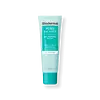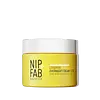What's inside
What's inside
 Key Ingredients
Key Ingredients

 Benefits
Benefits

 Concerns
Concerns

 Ingredients Side-by-side
Ingredients Side-by-side

Water
Skin ConditioningGlycerin
HumectantDiethylhexyl Carbonate
EmollientC12-13 Alkyl Lactate
EmollientDimethicone
EmollientCetearyl Olivate
Panthenol
Skin ConditioningSorbitol
HumectantCetyl Dimethicone
EmollientHydrolyzed Hyaluronic Acid
HumectantSarcosine
Skin ConditioningPapain
Skin ConditioningTocopheryl Acetate
AntioxidantSorbitan Olivate
EmulsifyingGlyceryl Stearate
EmollientCetearyl Alcohol
EmollientButylene Glycol
HumectantPentylene Glycol
Skin Conditioning1,2-Hexanediol
Skin ConditioningXanthan Gum
EmulsifyingAmmonium Acryloyldimethyltaurate/Vp Copolymer
Acrylates/C10-30 Alkyl Acrylate Crosspolymer
Emulsion StabilisingCarbomer
Emulsion StabilisingAlgin
MaskingCaprylyl Glycol
EmollientN-Hydroxysuccinimide
Skin ConditioningCitric Acid
BufferingSodium Hydroxide
BufferingPhenoxyethanol
PreservativeSodium Benzoate
MaskingParfum
MaskingCI 14700
Cosmetic ColorantWater, Glycerin, Diethylhexyl Carbonate, C12-13 Alkyl Lactate, Dimethicone, Cetearyl Olivate, Panthenol, Sorbitol, Cetyl Dimethicone, Hydrolyzed Hyaluronic Acid, Sarcosine, Papain, Tocopheryl Acetate, Sorbitan Olivate, Glyceryl Stearate, Cetearyl Alcohol, Butylene Glycol, Pentylene Glycol, 1,2-Hexanediol, Xanthan Gum, Ammonium Acryloyldimethyltaurate/Vp Copolymer, Acrylates/C10-30 Alkyl Acrylate Crosspolymer, Carbomer, Algin, Caprylyl Glycol, N-Hydroxysuccinimide, Citric Acid, Sodium Hydroxide, Phenoxyethanol, Sodium Benzoate, Parfum, CI 14700
Water
Skin ConditioningSqualane
EmollientCetearyl Alcohol
EmollientGlycerin
HumectantPentaerythrityl Tetraethylhexanoate
EmollientPolyglycerin-6
HumectantEthylhexylglycerin
Skin ConditioningAzelaic Acid
BufferingC15-19 Alkane
SolventMyristyl Myristate
EmollientGlyceryl Stearate
EmollientButyrospermum Parkii Butter
Skin ConditioningCeramide NP
Skin ConditioningCeramide AP
Skin ConditioningCeramide EOP
Skin ConditioningAcetyl Hexapeptide-1
Skin ConditioningNiacinamide
SmoothingPEG-100 Stearate
Phenoxyethanol
PreservativeInulin
Skin ConditioningBenzyl Alcohol
PerfumingCetearyl Glucoside
EmulsifyingSodium Lauroyl Lactylate
EmulsifyingAcrylates/C10-30 Alkyl Acrylate Crosspolymer
Emulsion StabilisingBetaine
HumectantAlpha-Glucan Oligosaccharide
CleansingCitronellyl Methylcrotonate
MaskingXanthan Gum
EmulsifyingSodium Hydroxide
BufferingDipotassium Glycyrrhizate
HumectantDehydroacetic Acid
PreservativePhytosphingosine
Skin ConditioningCholesterol
EmollientCarbomer
Emulsion StabilisingGlucose
HumectantCaprylyl Glycol
EmollientWater, Squalane, Cetearyl Alcohol, Glycerin, Pentaerythrityl Tetraethylhexanoate, Polyglycerin-6, Ethylhexylglycerin, Azelaic Acid, C15-19 Alkane, Myristyl Myristate, Glyceryl Stearate, Butyrospermum Parkii Butter, Ceramide NP, Ceramide AP, Ceramide EOP, Acetyl Hexapeptide-1, Niacinamide, PEG-100 Stearate, Phenoxyethanol, Inulin, Benzyl Alcohol, Cetearyl Glucoside, Sodium Lauroyl Lactylate, Acrylates/C10-30 Alkyl Acrylate Crosspolymer, Betaine, Alpha-Glucan Oligosaccharide, Citronellyl Methylcrotonate, Xanthan Gum, Sodium Hydroxide, Dipotassium Glycyrrhizate, Dehydroacetic Acid, Phytosphingosine, Cholesterol, Carbomer, Glucose, Caprylyl Glycol
Ingredients Explained
These ingredients are found in both products.
Ingredients higher up in an ingredient list are typically present in a larger amount.
Acrylates/C10-30 Alkyl Acrylate Crosspolymer is a synthetic polymer. It is used to thicken and improve the texture of products. Due to its properties, it can prevent water and oil ingredients from separating.
Caprylyl Glycol is a humectant and emollient, meaning it attracts and preserves moisture.
It is a common ingredient in many products, especially those designed to hydrate skin. The primary benefits are retaining moisture, skin softening, and promoting a healthy skin barrier.
Though Caprylyl Glycol is an alcohol derived from fatty acids, it is not the kind that can dry out skin.
This ingredient is also used as a preservative to extend the life of products. It has slight antimicrobial properties.
Learn more about Caprylyl GlycolCarbomer is a polymer of acrylic acid. Its main role is to create a gel consistency.
A high amount of carbomer can cause pilling or balling up of products. Don't worry, most products contain 1% or less of carbomer.
Cetearyl alcohol is a mixture of two fatty alcohols: cetyl alcohol and stearyl alcohol. It is mainly used as an emulsifier. Emulsifiers help prevent the separation of oils and products. Due to its composition, it can also be used to thicken a product or help create foam.
Cetearyl alcohol is an emollient. Emollients help soothe and hydrate the skin by trapping moisture.
Studies show Cetearyl alcohol is non-toxic and non-irritating. The FDA allows products labeled "alcohol-free" to have fatty alcohols.
This ingredient is usually derived from plant oils such as palm, vegetable, or coconut oils. There is debate on whether this ingredient will cause acne.
Due to the fatty acid base, this ingredient may not be Malassezia folliculitis safe.
Learn more about Cetearyl AlcoholGlycerin is already naturally found in your skin. It helps moisturize and protect your skin.
A study from 2016 found glycerin to be more effective as a humectant than AHAs and hyaluronic acid.
As a humectant, it helps the skin stay hydrated by pulling moisture to your skin. The low molecular weight of glycerin allows it to pull moisture into the deeper layers of your skin.
Hydrated skin improves your skin barrier; Your skin barrier helps protect against irritants and bacteria.
Glycerin has also been found to have antimicrobial and antiviral properties. Due to these properties, glycerin is often used in wound and burn treatments.
In cosmetics, glycerin is usually derived from plants such as soybean or palm. However, it can also be sourced from animals, such as tallow or animal fat.
This ingredient is organic, colorless, odorless, and non-toxic.
Glycerin is the name for this ingredient in American English. British English uses Glycerol/Glycerine.
Learn more about GlycerinGlyceryl Stearate is a mix of glycerin and stearic acid.
It is used to stabilize the mixing of water and oil ingredients. By preventing these ingredients from separating, it can help elongate shelf life. It can also help thicken the product's texture.
As an emollient, it helps soften skin and supports barrier-replenishing ingredients.
In cosmetics, Glyceryl Stearate is often made from vegetable oils or synthetically produced.
This ingredient may not be fungal-acne safe
Fun fact: The human body also creates Glyceryl Stearate naturally.
Learn more about Glyceryl StearatePhenoxyethanol is a preservative that has germicide, antimicrobial, and aromatic properties. Studies show that phenoxyethanol can prevent microbial growth. By itself, it has a scent that is similar to that of a rose.
It's often used in formulations along with Caprylyl Glycol to preserve the shelf life of products.
Sodium Hydroxide is also known as lye or caustic soda. It is used to adjust the pH of products; many ingredients require a specific pH to be effective.
In small amounts, sodium hydroxide is considered safe to use. However, large amounts may cause chemical burns due to its high alkaline.
Your skin has a natural pH and acid mantle. This acid mantle helps prevent harmful bacteria from breaking through. The acid mantle also helps keep your skin hydrated.
"Alkaline" refers to a high pH level. A low pH level would be considered acidic.
Learn more about Sodium HydroxideWater. It's the most common cosmetic ingredient of all. You'll usually see it at the top of ingredient lists, meaning that it makes up the largest part of the product.
So why is it so popular? Water most often acts as a solvent - this means that it helps dissolve other ingredients into the formulation.
You'll also recognize water as that liquid we all need to stay alive. If you see this, drink a glass of water. Stay hydrated!
Learn more about WaterXanthan gum is used as a stabilizer and thickener within cosmetic products. It helps give products a sticky, thick feeling - preventing them from being too runny.
On the technical side of things, xanthan gum is a polysaccharide - a combination consisting of multiple sugar molecules bonded together.
Xanthan gum is a pretty common and great ingredient. It is a natural, non-toxic, non-irritating ingredient that is also commonly used in food products.
Learn more about Xanthan Gum